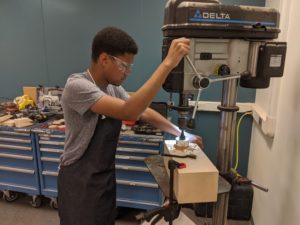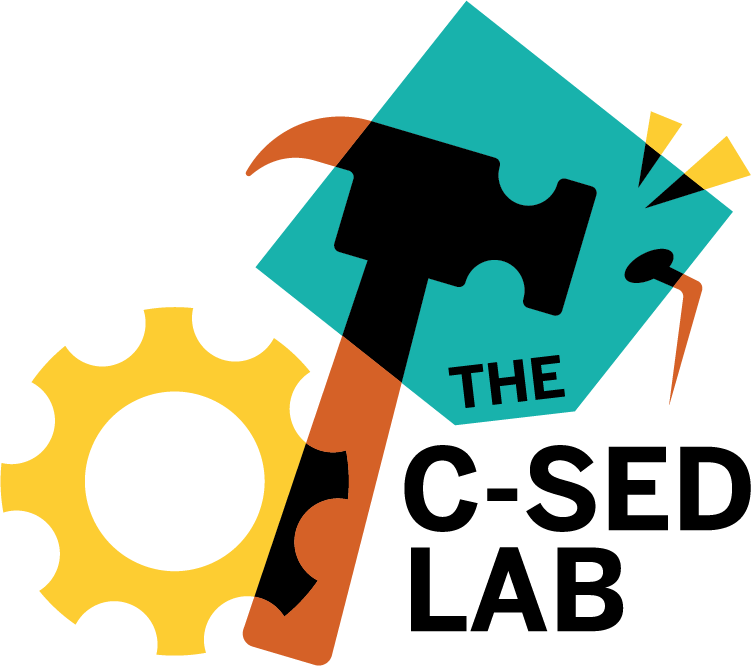How the C-SED Lab is creating an inclusive makerspace
Nestled on the third floor of the GG Brown Building, the C-SED lab greets you with glass walls and a collection of various tools. It is open to anyone willing to learn, as the intention behind its design was to foster inclusivity.
Story by Sydney Moore
The lab is set up in a way that allows you to indulge your creativity in a low-stakes environment. The lab managers, Shannon Clancy and Kaylla Cantilina, are both women deep into their engineering PhDs. They know firsthand how hard it can be to feel that you belong in makerspaces. Most makerspaces are filled with people who seem to know exactly what they are doing, and that can be very intimidating. It’s not easy to walk in confidently as a newbie. That’s why the C-SED lab’s mission statement is so revolutionary: there are no rules or limits on what you can make. As long as you supply the resources, the only constraint on what you can create is your imagination.
The lab sees a wide variety of projects come through: from a theremin designed by a Mechanical Engineering 450 capstone team to a surfboard personal project. People have come in to make light suits for the dance team and hangboards for climbing. Cutting boards prove to be a holiday favorite year after year.

View from outside of the lab
The lab’s process goes something like the following: anyone from an engineering team to a non-engineering student with a personal project can sign up for time in the lab. When you come in, Shannon and Kaylla help you establish learning goals. They ask you what experience you have with tools, what you are trying to build, and what you ultimately want to get out of space. But besides safety lessons and self-set learning goals, everything that takes place in the lab should be for fun.
That being said, Charlie Michaels, the C-SED staff member who oversees the lab, is going into the relaunch of the lab hoping to create a space where people aren’t afraid to make mistakes. Charlie has a background in art and design, which taught him that learning is a continual process of failing, talking through what you did, and trying again. His degree emphasized learning through building and experimenting, and he wants the lab to be a space where students of all disciplines can engage in this kind of learning. He hopes people come into the lab to try new ideas without the fear of failure. This principle echoes C-SED’s larger mission statement, which embraces ambiguity and focuses on whether you are asking the right question rather than finding the right answer.
This strong mission statement is exactly why the C-SED lab recently decided to rebrand. The space used to be called the C-SED prototyping lab, but that name was too limiting because people took it to mean that the lab was solely for those that ‘already had an idea and just needed to make a mock-up’. In reality, prototyping can happen at any point in the design process, even if you are just exploring a new challenge or idea. With that in mind, C-SED removed the word prototyping from the name to make sure it was clear to everyone that this was a space for prototyping and more. Within the new logo, there are elements representing these various activities that can take place in the lab: a sticky note for ideation, a hammer for low tech activities, a gear for high tech ones, and a bent nail to signify that it’s okay to make mistakes. Through this rebranding, those involved with the lab are hoping that the wider university community will come to see them as a space that actively breaks down barriers to accessibility and inspires safe experimentation.

One of the two rooms within the lab’s makerspace
Shannon is excited about this new logo and branding because it showcases the direction they want to take with the lab. The lab represents a space where everyone should feel welcome and learn together. As a prime example of that, Shannon and Kaylla are focusing on teaching people that the tools aren’t scary as long as you respect them.
As far as favorite tools go, the Miter saw is Shannon’s favorite. She explained that it’s called a Miter saw because of the different angles you can make cuts at, like the joints on a picture frame. The Router and bandsaw are Kaylla’s favorites. Charlie prefers the Table saw. It is typically a very dangerous tool because the blade is fully exposed. However, the saw stop makes it so that if a finger or piece of a person’s body comes close to the blade then the blade quickly stops and snaps down into the table. If you’re curious, look up the hot dog test to see how well this technology works.

Going forward, the lab would like to hold more mini classes and workshops. These events will prioritize people who have no prior experience, and you won’t need an engineering or design degree to participate. In the past the lab has done workshops on how to build a speaker system, which came in handy since headphones aren’t allowed in the lab for safety reasons.
For more information, check out the lab’s page on the C-SED website and submit a lab application if you’d like to be trained on how to use the tools. Sign up for the C-SED interest form to stay updated on what’s happening in the lab this year! And if you’re curious about the process of unhindered design, please feel free to make the trip up to the north campus and visit the C-SED lab.



